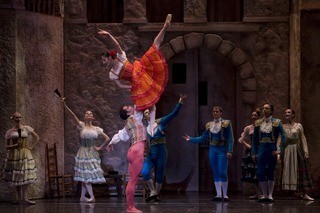|
Back
Don Quixote sparkles at Symphony Hall Phoenix
Symphony Hall
02/10/2011 - & February 11*, 13, 13, 2011
Ludwig Minkus (arr. by John Lanchbery): Don Quixote
Ballet Arizona principal dancers and chorus, Ib Andersen (Artistic Director), students of the School of Ballet Arizona, Paola Hartley (Kitri/Dulcinea), Astrit Zejnati (Basilio), Daniel Baudendistel (Don Quixote), Sergei Perkovski (Sancho Panza), Amanda Eddleman (Dulcinea Vision), Donald Dadey (Lorenzo/Kitri's Father), Joseph Cavanaugh (Gamache), Chelsea Early (Queen of Dryads), Kendra Mitchell (Cupid)
Olga Evreinoff, after Marius Petipa (Choreography), Alun Jones (Scenic Design), Nicholas Georgiadis (Costume Designer), Michael Korsch (Lighting Designer)
The Phoenix Symphony Orchestra, Timothy Russell (Conductor)

P. Harley & A. Zejnati (© Rosalie O'Connor/Ballet Arizona)
Based on a minor episode from volume II of Miguel de Cervantes' picaresque novel El ingenioso hidalgo don Quijote de la Mancha, and set to Ludwig Minkus' memorable score, this classic is a ballet lover's favorite.
Don Quixote was originally mounted in 1869 at Moscow's Bolshoi by a dancer and choreographer of genius, Marius Petipa, a Frenchman from Marseilles. Later choreographers - and composers - have added their personal touch, but today, the 150-year-old choreography remains authoritative and unrivaled, just like the many others that Nicholas II's Maître de Ballet created: Paquita, Le Corsaire, Raymonda, La Bayadère, Swan Lake, Coppélia, The Nutcracker, just to name a few. The name "Petipa" is not about to disappear from ballet companies' rosters.
Set in the streets of Barcelona towards the beginning of the 17th Century, the libretto tells the story of Kitri, an impudent village girl and her adventures with her sweetheart, Basilio, the local barber. In spite of Kitri's father's vain efforts to force her to marry the unwholesome but wealthy Gamache, love will prevail and Don Quixote, the errant knight, will be instrumental in arranging a happy ending.
The direction of this Ballet Arizona production is exuberant, energetic and plunges the spectator in the tradition of classic ballet. Sets are fairly bland and do not add much to the visual aspect. Costumes owed to Nicholas Georgiadis are cut in rich and colorful fabrics. Dancers make flamboyant use of broché yardage, the matadors swinging their lamé capes into orbit at least a dozen times over their heads, while Paola Hartley spins her Spanish dress with unabashed gusto. No time-out in this vivacious, elaborate choreography where company dancers display refined technique, especially in the dance of the matadors (Act 1), in the allegretto of Don Quixote's dream, including the endearing little cupids brought in from the School of Ballet Arizona (Act 2), or in the fiery fandango of Act 4. First dancers Paola Hartley (Kitri/Dulcinea) and Astrit Zejnati (Basilio) meet all the technical challenges of the demanding pas de deux of Act 4 with grace and panache, while Hartley's twenty-eight fouettés rond de jambe en tournant of her second variation are beyond reproach. Daniel Baudendistel as Don Quixote and Sergei Perkovski as Sancho Panza bring distinction and character to their parts with noticeable elegance, particularly in the emotion-packed second scene of Act 2 where the melancholy knight, unconscious, dreams of cupids and dryads under a stunningly beautiful starry sky.
In the pit, the ever so talented Phoenix Symphony Orchestra, under Timothy Russell's baton, delivers an enthusiastic, polished performance, drawing a remarkably expressive and nuanced sound from the musicians. We cannot wait to hear them in a Brahms, Jongen, Widor program next week.
Ballet Arizona
The School of Ballet Arizona
The Phoenix Symphony Orchestra
Christian Dalzon
|